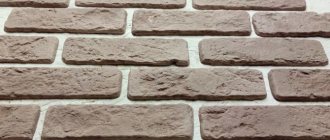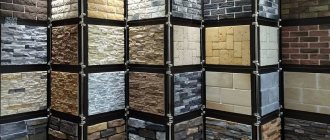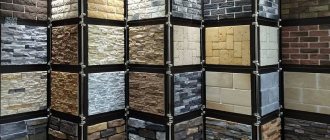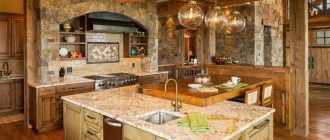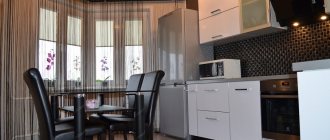You can use decorative stone in the kitchen interior in different ways: make a countertop, decorate the frying area, turning it into a hearth, or even lay out the entire kitchen backsplash. This will give the interior elements of primitiveness and at the same time a lot of grace. An undoubted advantage of decorative stone for the kitchen is its resistance to chemical, thermal and mechanical influences.
Photo: hausmobel.info
4. Decorative stone and lighting
A composition of stone and light can be an excellent interior decoration. The volume of the wall created by the stone, with the right lighting, can give your home the appearance of a small exhibition or a mysterious castle. With the help of light, you can highlight figurines, vases and other home decorations, which will look very advantageous.
Photo: usualhouse.com
Decorative stone and arches
Calculate the exact cost of repairs using an online calculator
and receive a free detailed estimate for repairs
Calculate
Decorating arches with decorative stone in an apartment as in the photo will bring a feeling of spaciousness and integrity to the room and emphasize the majesty of large rooms.
Photo: grassfire.org 6. Decorative stone at the front door
Decorating the front door with decorative stone will make your hallway look separate and attractive, as if in a photo from a magazine. A shelf with original things will add beauty and personality. The stone, in turn, will create a rich appearance. And pleasant dark colors will add a cozy atmosphere to the interior of your corridor.
Photo: fauxpanels.com
Decorative stone and tiles
Decorative stone can be presented in various shapes and colors. Quite an interesting solution - stone, finished as a tile that looks stylish, can fit beautifully into a minimalist interior, emphasize the clear contours of the room and give it volume.
Photo: squarespace.com
Obvious advantages of the solution
Unlike natural stone, any imitation of it has every chance of fitting into the interior of an ordinary city apartment due to the increased practicality of the material and its technical characteristics. Moreover, in some cases, such a solution can give a solid head start to already well-proven finishing materials.
- low load on the walls
- most imitations are lightweight, so the elements can be fixed using ordinary tile adhesive or even liquid nails; - resistance to ultraviolet rays
- no fading of the texture even after prolonged exposure to the sun; chemical safety - the components do not contain any reagents hazardous to the human body, so you can decorate any room in your apartment with finishing stone for the walls, even the nursery; - resistance to mechanical stress
- of course, it is difficult to compare with natural stone in this indicator, but there is a good reserve; - simple installation
- practically no different from laying ordinary ceramic tiles, and in some cases it is even much easier - with gypsum stone, for example; - environmental friendliness
- even if the finishing stone imitates natural stone, it remains completely environmentally friendly due to the use of natural ingredients; - a wide choice of textures
is an obvious advantage of imitations, since you can choose absolutely any stone with a convincingly executed texture, and also subject it to post-processing, for example, paint or varnish; - affordable price tag for all options
- for many, it is the affordability of the price that will be the determining factor, and it’s hard to disagree with its attractiveness: natural stone costs an order of magnitude more.
Decorative stone and mosaic
An interesting solution is a small decorative stone in the interior of the living room. The photo shows one of these options. The varied colors and small size of the stones make it possible to create a very beautiful composition on the wall, which will become a prominent place in your home and will make both you and your guests delight.
Photo: clipgoo.com
Preparation for finishing
First you need to calculate the amount of material. If the stone will cover the entire area of the walls in the hallway, you should subtract the area of the openings and add 10%. If the decor will be located around openings, niches, in separate fragments on open walls, draw a rough sketch of the decoration and take measurements of each area. Then add up the area and add 10-15% for trimming. When purchasing material, you should remember that the amount of stone with an angular shape is calculated in linear meters, and of a regular shape - in square meters.
Artificial stone in the hallway
Additionally you will need:
- hacksaw or grinder (depending on the type of stone);
Bulgarian - simple spatula 7-9 cm;
Putty knife - notched spatula 15-17 cm;
Notched trowel - level;
Professional cast Kapro level - long ruler;
- pencil;
- paint brushes;
- varnish;
- file;
- acrylic primer.
Acrylic primer for walls
Artificial stone can be attached using liquid nails, cement-based or gypsum-based glue. The glue consumption must be indicated on the packaging, so when purchasing, you should know exactly the finishing area and take it with a small margin.
Liquid Nails
Types of liquid nails
If you use gypsum stone, you will need a special miter box with high sides for cutting.
Plastic miter box
When everything you need has been purchased, you should start preparing the surface.
Step 1. Dismantling the coating
Removing the coating
If the stone covers the hallway walls completely, the old coating is removed completely to the base. If separate areas are intended for decoration, the coating must be dismantled very carefully. On the wallpaper, mark the boundaries of the finish with a pencil and carefully trim it with a utility knife, leaving a margin of 1-2 cm wide for stones. The wallpaper glue is soaked in water and removed with a spatula, and the walls are thoroughly washed. They also remove the paint if it is peeling or cracked, and clean off any loose plaster.
Step 2. Leveling the walls
Putty
Laying the stone should be done on a flat, smooth surface - this will facilitate the work process and increase the strength of the decorative coating. Therefore, all small cracks, gaps, and depressions are filled with putty, and if there are differences of more than 5 mm, it is better to plaster the entire area. Particular attention should be paid to doorways: deep cracks may form around the perimeter of the frame, for sealing which it is recommended to use a cement solution.
Prices for mixtures for leveling walls and ceilings
Mixtures for leveling walls and ceilings
Step 3: Priming
Priming
Dry walls must be lightly sanded to smooth out the unevenness of the puttied areas, and then wiped with a rag to remove dust. After this, the surface is treated 1-2 times with an acrylic primer. If there is wallpaper around the perimeter of the areas to be treated, the primer should be applied so as to cover an edge 1 cm wide - what will be hidden under the cladding.
Decorative stone and walls
Decorating the wall with decorative stone, as in the photo, will definitely attract your attention. Such a wall will focus on a certain part of the room, in which you can group other interesting interior details. This technique will enliven the atmosphere and create a cozy corner in your home.
Photo: thenhhouse.com
Decorative stone and sculptures
Decorative stone is a material that can be used in various shapes and colors, which gives us the opportunity to make an amazing thing out of it, such as a sculpture on the wall. Such works look very expensive and solid. It feels like you are in a museum.
Photo: myshindigs.com
Installation
Laying stone by specialists per square meter is carried out at a low price, but performing work over a large area will cost a pretty penny. Therefore, it is possible to consider the option of self-installation, the sequence of actions of which is as follows:
Preparation, according to many experts, is an important step. It is necessary to clean the working surface (the base for finishing) from previous coatings, dust, dirt, debris, and level it. If there is a possibility of fungus formation, prevention is needed. Prepare the necessary tools : pliers, a grinder and sandpaper, a construction mixer, a level, brushes for cleaning seams, spatulas and a brush, a rag, a bucket, a grinder or a hacksaw for trimming. A primer must be applied to the base and reverse side of the facing material. Mark the surface.
Reference. It is recommended to lay out the proposed stone composition on the floor and number the elements, which will facilitate installation. If necessary, adjust products to size.
Important! Work should be carried out at a room temperature of +5 to +30 degrees. At higher temperatures, twenty minutes before starting installation, it is necessary to moisten the base and the back of the stone with water.
Laying is carried out in accordance with certain rules:
- the adhesive solution is prepared for 15-30 minutes of work, later it hardens;
- a notched trowel is used to apply the glue;
- installation should begin from the corner, from bottom to top;
- glue is applied to the back side of the stone:
- the stone is pressed against the wall for a few seconds to ensure secure fixation;
- the width of the seam should not exceed 8 mm, the indicator is directly proportional to the size of the product;
- the seams are sealed with putty, the color of which can be changed by painting.
Decorative stone in the summer garden
Have you always wanted to create a garden in your apartment, but didn’t know how to do it? Our advice: using decorative stone. It can be used to create stunning and unusual shapes with a combination of stone and plants that will enliven your home.
Photo: diyhomedecor.co
The best modern materials for imitation brick
| Photo | Name | Rating | Price | |
| #1 | Gypsum | ⭐ 4.9 / 5 16 — votes | Find out more | |
| #2 | Clinker | ⭐ 4.85 / 5 4 - votes | Find out more | |
| #3 | Porcelain tiles | ⭐ 4.8 / 5 6 — votes | Find out more | |
| #4 | Acrylic | ⭐ 4.8 / 5 3 - votes | Find out more | |
| #5 | Flexible stone | ⭐ 4.75 / 5 5 — votes | Find out more |
What modern materials would you choose to imitate brick or would you recommend purchasing?
Take the survey
Decorative stone and rest room
If you have a relaxation room in your home or are just planning to create one, think about beautiful decoration so that you can really enjoy relaxing in such a room. And decorative stone can perfectly cope with such a task. It will give the interior coziness, spontaneity and warmth.
Photo: sesa-build.com
Decorative stone in the bathroom
Bathroom surfaces finished with stone look majestic and reliable, in addition, they are protected from dampness and rapid wear and have antibacterial properties. Stone and water create the effect of being in nature, as if a waterfall is roaring somewhere nearby.
Photo: freshpalace.com
